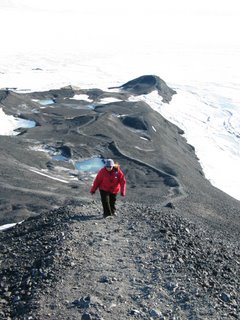McMurdoisms

This picture was taken near the adelie penguin rookery at Cape Royds yesterday. I saw penguins, seals, and skuas. The penguins have chicks now. They are doing better this year now that the big iceberg has drifted away and the parents have a shorter distance to go and forage.
My trip yesterday inspired me to write about some aspects of life here. There are many common expressions and acronyms used in the USAP that may be confusing to people who have not been here. I thought I would try to explain a few of them.
Going portrait refers to turning your blue food tray vertically in order to accommodate more than 6 people at the round tables in the Dining Facility.
Rocket is a verb meaning to use the propane fired toilet at Lake Hoare Camp.
Grey water is a verb meaning to dispose of water in the grey water barrels.
Skua is a sea bird, the Antarctic gull, frequently spotted outside of Building 155 (aka the Galley or Dining Facility). If you are lucky enough to get to the penguin rookery at Cape Royds, you will see them there too. Skuas will eat many things and are not afraid to attack humans in order to steal their food. Yesterday at Cape Royds I witnessed two skuas snacking on a penguin chick.
Skua is also a verb meaning to take your unwanted items and put them in the reuse bins so that you don't have to bring them home when you redeploy (see below) and hopefully someone else will want to use them.
Skua is also a verb meaning to find or use something that was left in Skua by someone else.
Skua is a noun referring to the item left behind.
Example sentences:
Wow, you found that in skua? Hey, I skua-ed those pants. Check out my skua. Watch out, here comes a skua!
Lots of expressions have to do with coming to and leaving Antarctica.
Deployment means traveling to Antarctica.
Orange bags: The extreme cold weather (ECW) clothing that we get from the Clothing Distribution Center (CDC) in Cheech is packed in orange bags.
Cheech: Christchurch, NZ
Movement Control Center (MCC), Building 140: This is the building where you go when it's time to bag drag (see below) before you redeploy (see below).
Redeployment does not mean traveling to Antarctica again. It means, undeployment, or the trip back home.
Bag Drag is the process of bringing your luggage to the MCC so that it can be palletized and brought out to the airfield. This happens the night before your scheduled flight. You are allowed to keep one orange bag after bag drag. You are advised to keep some spare clothing in case the plane does not arrive as planned. If you don't have a change of clothes, you may have to skua some.
PAX are passengers.
Winter is a verb meaning to stay in Antarctica through the winter, from station close in February through August. There are no planned flights to USAP stations during this time. In January, people start to ask, "When do you redeploy or are you wintering?"












